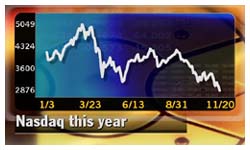|
What happens to techs?
|
 |
November 21, 2000: 6:36 a.m. ET
Spring brought no bounce and fall has fallen further. What do investors do?
By Staff Writer Alex Frew McMillan
|
NEW YORK (CNNfn) - Will the tech carnage never end? It's been an ugly year. Now, with election uncertainty and a slowing economy, the Nasdaq grinch is stealing the holiday spirit out of investors' portfolios.
Many market watchers say sectors like pharmaceuticals, financials or biotech hold better prospects, short-term. Everyday investors seem to have shaken the idea that tech is the only place to post above-average returns.
What should investors do? There's good reason to continue to be cautious about the sector before buying back in, stock watchers say. But it's likely already too late to sell if you haven't already.
"I think the idea is to buy low and sell high," said a wry Peg Eddy, president of Creative Capital Management and a financial planner. Investors who cut their losses now may be trying to catch a falling knife, she said. They'll get cut instead.
An end to the optimism
There's little reason to be excited about the sector. "Outside of tech is better than tech," said Bernie Schaeffer, director of Schaeffer's Investment Research. "But the analyst community has not deserted this [sector], in my mind."
Schaeffer, who likes to measure sentiment, expects a tech rally to start only when sentiment is completely bearish. That ensures the selling is done with, he said.
| |

|
|
| |
|
|
| |
Just like it looked like they're never going to stop going up, now it begins looking to many investors like they're never going to stop going down.
|
|
| |
|
|
| |

|
|
| |
|
|
| |
Ted Weisberg
Seaport Securities |
|
Lingering optimism leaves room for a lot more downgrades, he continued. And investors seem only to respond to bad news such as downgrades at the moment. Even when a tech company outperforms on earnings, its stock typically doesn't get much of a boost.
Market watchers are hesitant to predict bottoms. But Ted Weisberg, president of Seaport Securities, told CNNfn's Street Sweep that he believes the selling will be over when tech stocks stop retreating on bad news.
"It's the complete reverse of the psychology we had in the first quarter of this year and the fourth quarter of last year," he said. "Just like it looked like they're never going to stop going up, now it begins looking to many investors like they're never going to stop going down."
Few buyers stepping in
Year-end tax selling has exacerbated the losses, market watchers say. Institutions are also repositioning, and their trading is amplified in what has been relatively light trading this fall.
 There are plenty of signs that retail investors, burned by the tech crash this spring, are sitting on the sidelines. Online trading volumes have declined again after a burst in October. And there's a lot of money sitting in the bank. There are plenty of signs that retail investors, burned by the tech crash this spring, are sitting on the sidelines. Online trading volumes have declined again after a burst in October. And there's a lot of money sitting in the bank.
Savings in bank accounts and small certificates of deposits grew by $64 billion in October, according to Trim Tabs Financial Services.
Without buyers stepping in, bad stock-market news is amplified. The market was overly exuberant pricing techs on the high side. Now it is overly negative marking them down, Weisberg said. At some point, the market will snap back.
Looking for bottom
The seemingly eternal question is when. How to play technology depends on your time frame, of course. Most market watchers encourage long-term investors to sit tight. If they are sufficiently diversified, they can look to good news from the unsexy parts of their portfolios such as bonds, financials and energy stocks.
"It's almost too late to sell now," said Greg Zandlo, president of North East Asset Management and a certified financial planner.
Schaeffer believes the worst possible bottom for Nasdaq is somewhere in the 2,500-to-2,600 range. If Schaeffer is correct, that means the downside is  very limited. But short-term, tech investing is unlikely to be a picture that gets prettier rapidly, he said. very limited. But short-term, tech investing is unlikely to be a picture that gets prettier rapidly, he said.
Others think Nasdaq will drop further. Chris Grisanti, a principal at W.G. Spears Grisanti & Brown, said the low 2,000s isn't out of the question.
Plenty of big-name tech stocks are still very highly valued, such as Cisco (CSCO: Research, Estimates). Even though Cisco is trading around the same price as it started 2000, its price is still 65 times its projected earnings for fiscal 2001.
So while there are odd tech bargains at the fringes of the market, "we think that the middle of the bell curve is still pretty high," Grisanti said.
No year-end boost yet
The year-end effect, where new retirement-plan and bonus money tends to boost the market, has shown no sign of kicking in yet. The traditional rally isn't out of the question, Grisanti said. But his company "stepping out of the way [of tech stocks] as they pass us on the way down," he said.
Schaeffer advised investors to sell out of stocks that have been pummeled recently -- by which he means broadly held stocks such as Dell (DELL: Research, Estimates), Intel (INTC: Research, Estimates), Lucent (LU: Research, Estimates), Apple (AAPL: Research, Estimates), AT&T (T: Research, Estimates), Worldcom (WCOM: Research, Estimates) and so on. "Dump all those underperformers," he advised.
While broader technology indexes might recover, not all tech stocks will. So Schaeffer said tech investors might consider taking the money they generate from selling their losers and putting it in an index-mapping stock or fund – the Cubes (QQQ: Research, Estimates), perhaps, which map the Nasdaq 100. Zandlo also said that exchange-traded fund was beginning to look good.
Time for tax management
Of course, there is one glint in the very dark cloud of a Nasdaq that is down 29 percent so far this year. Investors actually have losses to offset their gains this year, meaning this is a good time for some tax management.
"If you've had some real winners, lucky you," Eddy said. "If you want to reposition, the only good part is, you're going to be able to absorb some of the gain [with losses]."
Planners recommend trying to maximize short-term losses -- on stock held less than 12 months -- against short-term gains. Short-term gains are taxed as ordinary income. For the majority of investors, that is higher than the 20 percent long-term capital gains rate, for investments held longer than a year.
Short-term losses offset short-term gains first. Then they count against long-term gains. So short-term losses are "worth more" if they offset short-term gains, saving tax at a higher rate.
If investors are unlucky enough to have losses that outweigh their capital gains, they can charge up to $3,000 in losses against ordinary income. All other losses are carried forward to count against gains or income in future tax years. 
|
|
|
|
|
 |

|

